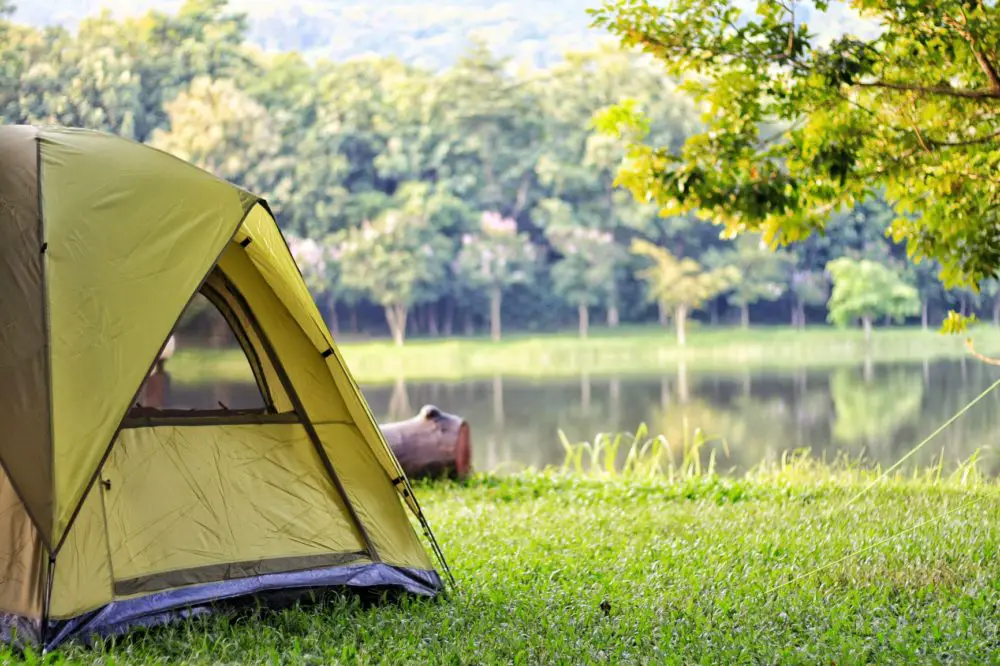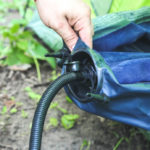We’ve all woken up boiling hot in a tent, and the feeling of being overly hot is pretty much as bad as feeling freezing cold.
One way around this is to air condition your tent.

To do this, you’ll need a tent that has been specifically designed with an AC port so that you can hook up a portable AC unit.
You’ll also need a tent or camping AC unit, and there are two main types to choose from: a window AC unit or a free-standing unit.
Table of Contents
Window AC Units and Tents
Window AC Units are the most popular choice for air conditioning your tent. These are used along with a specially-designed tent that has an AC window port to hook up your unit.
If you do go with a window AC unit, it’s best to select a small-sized one. This is because you’re only trying to cool a small space, as well as the fact that smaller units will have fewer BTU’s so your tent is less likely to become too cold or damp.
Something like Frigidaire 5,000 BTU Window Mini-Compact Air Conditioner is a good choice. This compact window AC unit quickly cools an area of up to 150 square feet with dehumidification up to 1.1 pints per hour.
It’s easy to use and is versatile thanks to its 2 cool speeds and fan speeds, as well as its 2-way air direction. It’s also energy-efficient, with a low power start-up, quiet operation, and effortless restart.
Free Standing AC units
The other option when it comes to tent air conditioners is a freestanding unit. With these, the AC unit is used inside the tent rather than outside of the tent.
These units sit inside the tent and usually come equipped with a hose that runs outside. Some campers prefer these as they don’t require an AC port.
Not only this, but they reduce the risk of theft, as the only thing visible from the outside of the tent is a small hose, so this limits unwanted attention.
As well as not needing an AC port, they’re also handy as they don’t require an AC stand, either, and simply sit directly on the ground of your tent. However, this does mean that they tend to take up a little more of your interior space, which isn’t ideal if you’re in a smaller tent or camping with several other people.
The Rosewill Portable Air Conditioner 8000 BTU, AC Fan & Dehumidifier has a compact size and lower BTU rating. It’s also energy-efficient thanks to its built-in Sleep Mode and ability to program times of use or shut-off with the automatic on/off timer which can be programmed up to 24-hours.
Other ways to air condition a tent
Aside from an air conditioning unit, there are several other ways in which you can keep your tent cool.
Tent Fan
A tent fan is an affordable and space-saving option for boosting air circulation in your tent.
While these won’t be as powerful as an AC unit, they’re a lot more compact and can be hung from the ceiling of your tent. Some also double up as a light.
This tent fan from Amazon features a built-in double rechargeable battery that can last upwards of 5-48 hours non-stop when fully charged.
It also can work with a USB cable powered by a laptop, car charger, or power bank, and has a solar charging panel on the top if these options aren’t available. It also has 360-degree rotation which will help circulate the airflow in your tent.
These are best for smaller tents though, as for a larger family tent you’ll probably need a larger AC unit to effectively cool the bigger space.
Insulating your tent
Insulating your tent isn’t just for cold weather, as insulating can also help keep your tent cool, too.
Whereas in the winter you’d insulate your tent from the inside using a reflective foam or emergency foil blanket, in the summer months you can reverse this principle: cover your tent on the outside with one of these options, ensuring the reflective side is facing up to space to send any heat back where it came from.
Maximize ventilation
Tents often feel stuffy and dry due to a lack of ventilation, particularly in single-walled tents.
Some double-walled tents allow you to maximize ventilation by removing the rainfly. Many also allow you to open the windows, though will have a mesh covering to keep bugs out.
Maximizing your ventilation is an easy way to stop the air inside the tent from becoming stale, but this is harder if you’re camping in the rain and want to reduce the chances of water getting in.
Improvised swamp cooler
One way to increase the effectiveness of a tent fan is to place a bucket of ice water in front of your fan. This way, as the water evaporates, the fan will blow the cool water over you.
This works well as an improvised swamp cooler but won’t be as effective in very humid conditions.
Choose a shaded spot
You can also do yourself a favor by choosing a shaded spot when you set up camp.
This sounds obvious, but being out of the sun, or shaded by some trees and bushes will make a big, big difference.
Create a tarp shade
If you don’t have any natural shade, create your own shade or shelter out of a tarp and some rope.
You can tie it to some trees and hang it directly over the tent as an extra layer to block out the sun, or alternatively take along some extra poles to fix it to.
This is also super handy for doubling-up as a rain shelter and can be set-up away from your tent if you want an area to socialize or cook underneath.
Final Verdict
The easiest and most effective way to air condition your tent is with a specially-designed AC unit, however, if you don’t have the power outlet or space available to accommodate one of these, there are numerous other ways in which you can keep your tent cool and comfortable, and the best way to do this is usually by combining the above methods or finding out which ones work best for you.
- Are Merrell Shoes Good? – An Unbiased Review of Merrell Footwear - December 9, 2023
- Where Are Merrell Shoes Made? - December 9, 2023
- Camping in 40-degree Weather: Tips and Tricks - September 25, 2023

![Two Pairs of Socks When Hiking? [Advantages & Disadvantages] Two Pairs of Socks When Hiking? [Advantages & Disadvantages]](https://grandcircletrails.com/wp-content/uploads/2022/07/Should-You-Wear-Two-Pairs-of-Socks-When-Hiking-150x150.jpg)

![Why is My Air Mattress Deflating but No Holes? [5 Possible Reasons] Why is My Air Mattress Deflating but No Holes? [5 Possible Reasons]](https://grandcircletrails.com/wp-content/uploads/2021/09/Why-is-My-Air-Mattress-Deflating-but-No-Holes-1-150x150.jpg)


